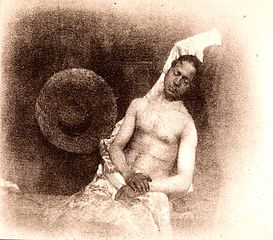English & Creative Writing Research Seminar
Breathless: the look of drowning in early underwater photography
Speaker: Dr Matt Kerr (University of Southampton)
3.30-5pm on Wednesday 30th November 2016
in Babbage 406, Plymouth University

This paper investigates the imaginative links between photography and drowning in the nineteenth and early twentieth centuries. If photography can be thought of as an art of surfaces, photographs of drowning are distinguished by their relationship to immersion—to depth.
I begin with Hippolyte Bayard’s protest picture, Self Portrait as a Drowned Man (1840), which showed Bayard, shirtless, in a darkened room, with closed eyes and somewhat blurred hands. The accompanying caption punningly explained the sitter’s ‘decayed’ state in terms of his obscurity: ‘He has been at the morgue for several days, and no-one has recognized or claimed him. Ladies and gentlemen, you’d better pass along for fear of offending your sense of smell, for as you can observe, the face and hands of the gentleman are beginning to decay.’
Why does Bayard adopt the figure of the drowned man to symbolize his plight as a neglected pioneer of photography? What might the relationship be between Bayard’s self-portrait, and aspects of photographic technique that recall drowning (including exposure and immersion)? And how does Bayard’s image reproduce or revise other visions of drowning in the long nineteenth century? This paper considers these questions, among others.
I will range broadly over literary and visual texts including Thomas De Quincey’s ruminations on drowning, the early underwater photography of Louis Boutan, Dickens’s contemplation of drowned bodies in The Uncommercial Traveller, representations of L’Inconnue de la Seine, and the scenes of drowning (and drowned bodies in the Paris morgue) in Zola’s Thérèse Raquin.
